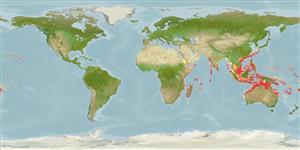Classification / Names
Common names from other countries
Main reference
Size / Weight / Age
Max length : 70.0 cm TL male/unsexed; (Ref. 5578)
Length at first maturity
Lm 27.6, range 12 - 46.5 cm
Environment
Marine; reef-associated; depth range 0 - 170 m (Ref. 89055), usually ? - 90 m (Ref. 9840)
Climate / Range
Tropical, preferred ?; 33°N - 33°S, 28°E - 154°W
Distribution
Indo-Pacific: Red Sea (Ref. 9840) and East Africa to Samoa (Ref. 592) and Tonga (Ref. 53797), north to Japan, south to Australia (Ref. 9840). Represented by multiple color morphs in the Indo-Pacific which may be different species (Ref. 9840).
Countries | FAO areas | Ecosystems | Occurrences | Introductions
Short description
Dorsal
spines
(total): 0;
Dorsal
soft rays
(total): 0;
Anal
spines: 0;
Anal
soft rays: 0. Reddish brown with blue centered bright ocelli and scattered black spots dorsally, white ventrally (Ref. 3263). Snout very short and broadly angular; disc angular; tail as long as body with conspicuous black and white rings, and with a short upper caudal finfold but a longer lower one ending well behind tail tip; disc without thorns; usually one sting on tail (Ref. 5578).
IUCN Red List Status (Ref. 115185)
Human uses
Fisheries: commercial
More information
ReferencesAquacultureAquaculture profileStrainsGeneticsAllele frequenciesHeritabilityDiseasesProcessingMass conversion
Tools
Special reports
Download XML
Internet sources
Estimates of some properties based on models
Phylogenetic diversity index
PD50 = 0.5312 many relatives (e.g. carps) 0.5 - 2.0 few relatives (e.g. lungfishes)
Trophic Level
3.3 ±0.3 se; Based on diet studies.
Resilience
Very Low, minimum population doubling time more than 14 years (Fec=1-3)
Vulnerability
Moderate to high vulnerability (52 of 100)
Price category
